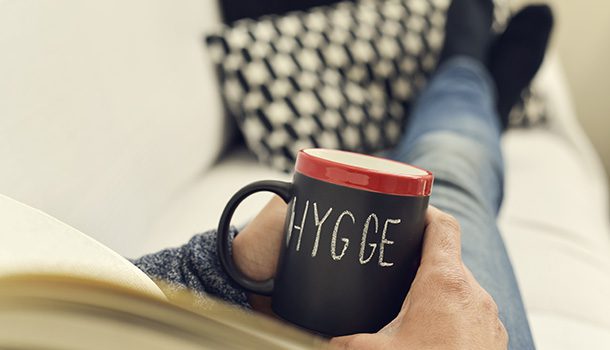Hygge – A Marketer’s Dream or the Secret to Happiness?

Another mass-marketed trend used to sell products, or the answer to our stress-filled digital lifestyles? Veronika Zavrelova dissects the communication context of ‘hygge’.
It seems that every year we are flooded with texts and images of a new lifestyle trend, with the implicit suggestion that it has all the answers. You know the drill – if we want to be able to successfully cope with the everyday rollercoaster of worry and time-management struggles, all the while preserving our mental health, we simply cannot live without the latest gimmick. 2016 was no different. Popular bookstore shelves, already overflowing with light reading on exercise, cooking, interior design, and the like promising the secret to a slow and spiritual life, had to make room for a new trend – this one originating not in the kitchens of Surrey or the gardens of California, but the Kingdom of Denmark.
The word hygge [hue-ga] is an organic part of the Danish vocabulary. It can function as a noun, an adjective or several other parts of speech, in a surprising number of ways. Many linguists say that the word hygge, like the German ‘gemütlichkeit’ or the Portuguese ‘saudade’, is so complex it is difficult to find an adequate equivalent in other languages. Hygge evokes the feeling of the ‘good life’, the ability to enjoy the manifestations of the ordinary life in its simplicity, of an unpretentious beauty and uncomplicatedness, of inner peace rather than outward excitement and of modesty rather than superficial luxury. In the course of everyday life, it can mean an emphasis on quality living: the ability to stop for coffee and cake during the working day, and to come home from that same job at a reasonable hour and have time to eat a home-cooked dinner at a tastefully arranged table with the whole family. Above all, hygge reflects the understanding that ordinary moments are more important and more formative than the moment when the champagne cork pops.
The shift toward a slower pace of life, with an emphasis on community, and a retreat from the fast, competitive pace of the rat race, is in fact a fairly representative reflection of Danish cultural values. Denmark ranks high among countries with a low power distance, and an emphasis on equality (abiding by the “Law of Jante”, based on a fictitious city where laws apply to all equally), in the sense of not being pushy with one’s opinions, and resisting the urge to put oneself before others. A fundamental feature of Danish society is its gentler culture with an emphasis on solidarity, generosity, and care for others, oriented toward maintaining relationships rather than competition, high performance and outcomes. At the same time, it is still an individualist society where respect for privacy, free opinions and individuality is respected. This contrasts with the USA, for example, where competition is culturally-based and focused on performance, leadership, and the ability to prosper, which is also applicable and appreciated in cultures such as Great Britain or Germany.
How did the Nordic phenomena of hygge hit the top of the bestseller lists in such culturally dissimilar countries? The irony is that the global image of hygge comes not from the Danes themselves, but from the heads and hearts of predominantly British marketing, business and media professionals, skilled in successfully interpreting and, to a certain extent, ‘manufacturing’ social lifestyle trends. So much so that alongside such telling words as ‘Trumpism’ and ‘Brexit’, the word ‘hygge’ was shortlisted as Word of the Year in a number of British English dictionaries, including Collins and Oxford. It is perhaps not surprising that after the turbulent political events of last year, a term reflecting the quest for a relaxing lifestyle, based on the pursuit of happiness and joy in everyday activities, comes from British marketing executives. The popularity of the feeling that one can, albeit for a moment and on a small scale, control and influence the state of affairs with a wee bit of ‘hygge’ seems completely understandable in this context.
From a commercial point of view, the visual possibilities of ‘hygge’ make it particularly inviting for the media. Photogenic and easy to use in promotion, especially to target groups of middle-aged, educated, higher-income women living in larger cities – who can resist flaunting images of eloquently arranged flowers and home-baked bread? The essence of ‘hygge’ can be portrayed with eye-catching objects, yet simplicity is key, so as not to give the impression of exclusivity and wealth. It is probably not surprising that visually-oriented social networks and platforms such as Instagram and Pinterest experienced a sharp rise last year in the use of the #hygge hashtag, memes, videos and more.
A foreign country’s take on another country’s social and cultural phenomena (in this case, the British view of Danish ‘hygge’) is of course nothing unusual in describing and determining trends and style. Positive stereotypes are created and interpreted to act as a shortcut for the public, as they are easy to remember and sell. Look no further than the traditional American fascination with French esprit, and the countless columns that have been written on how to ‘feel Parisian’ even when living thousands of miles away. It is perhaps rather surprising that there are not more parodies of similar self-help and style manuals on ‘how to adopt the lifestyle’.
On the other hand, is it really necessary to roll our eyes and mock the hygge marketing explosion? There is surely much to be said for positive inspiration in the pursuit of happiness. The Copenhagen Institute for Happiness Research, an independent think-tank dealing with elements affecting human happiness, provides lots of useful ideas emanating from not only the Danish, but the entire Scandinavian region. After all, it may be only a few small steps from ‘hygge’ to improving conditions on the labor market, schools, social networks…
I will leave it up to you to decide whether ‘hygge’ is just another irritating trend bubble, or an essential part of a quality lifestyle. Whatever you decide, it can’t hurt to stop and smell the roses sometimes.
(This article is an edited version of the original “Hygge – dokonalé umění pohody kdykoliv” published in Psychology Today, March, 2017.)
Related Articles
UNYP Chronicle Newsletter
The e-mail address you provide will be used only to send you the newsletter. Your privacy is important to us.
For more information download our UNYP Brochure.

Contacts
University of New York in Prague
Londýnská 41, 120 00 Praha
ID no: 25676598
Phone:
+420 224 221 261
![]() Skype
Skype
Email: unyp@unyp.cz








